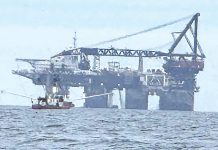
By Stephen Appezzato
NEW JERSEY – A coalition of environmental groups and fishing cooperatives has filed a federal lawsuit to block the construction of Empire Wind 1, the offshore wind farm that will be located about 19 miles east of Long Branch.
The groups, Clean Ocean Action (COA), Protect Our Coast New Jersey (POCNJ) and ACK for Whales, along with a list of fisheries, seafood co-ops, whale watch operators and civic leaders are asking the U.S. District Court to reinstate a stopwork order issued in April by U.S. Interior Secretary Doug Burgum, who had paused the project due to concerns over environmen- tal and procedural issues.
“We are asking the federal court to reinstate the stop work order because the project’s federal approvals were incomplete and failed to safeguard the ecology of our seacoast and the livelihoods it supports,” said lead counsel Bruce Afran in a news release. The stop-work order was reversed in May, just over a month after it was imposed, without explanation from the federal government. Now, the plaintiffs are seeking to block the project entirely, arguing it violates federal environmental regulations and the lease violates the Outer Continental Shelf Lands Act (OCSLA) by awarding U.S. offshore territory to a company controlled by a foreign government.
Empire Wind 1, slated to be one of the largest offshore wind farms in the U.S., while located 19 miles east of Long Branch, is under the jurisdiction of New York. If completed, the farm will consist of up to 130 wind turbines over 80,000 acres, powering about 1 million New York homes, according to Equinor, the company behind the project.
“A Government Accountability Office investigation released in April confirmed what we’ve long said: the offshore wind permitting process has been fast-tracked with rubber-stamp approvals, and it underscores and add(s) to a scandalous lack of sound science, due diligence, and due process – putting our marine environment at serious risk,” said COA executive director Cindy Zipf. “Secretary of Interior Burgum was right to stop the project due to these ‘serious deficiencies.’ Inexplicably, the decision was reversed,” she said.
“Now, massive pile-driving ships that can cause harm and even death to marine life are on their way, thus this legal action is essential,” she added.
The coalition also took issue with the fact the project is being developed by Equinor, a company 67% owned by the Norwegian government.
“New York’s increased electric rates will help fund a foreign government,” said Afran. “OCSLA does not permit leases to entities controlled by foreign states.”
Environmental Risks Cited
The lawsuit also raises concerns about the environmental risks posed by the project. Empire Wind is situated in a sensitive marine area, a vital habitat for commercially and recreationally important fish species and a migratory route for the North Atlantic right whale. According to the coalition, the project also entails “dumping 3.2 billion pounds of rock onto essential spawning grounds for scallops, squid, fluke and other marine life.”
Included among plaintiffs in the lawsuit are multiple New Jersey fisheries and seafood co-ops, such as the Belford Seafood Co-op.
According to POCNJ board member and Seafreeze Fisheries liaison Meghan Lapp, commercial fishing vessels will be “pushed off their domestic fishing grounds to make way for foreign-flagged vessels with foreign crews constructing a wind facility owned by the Kingdom of Norway, right in U.S. waters.”
“These are long-standing American small businesses employing thousands of U.S. workers whose livelihoods are at risk if Empire Wind proceeds,” said POCNJ president Robin Shaffer.
Alongside environmental and leasing concerns, the coalition noted the project site is located beneath flight paths to JFK and Newark airports and is in a busy maritime corridor, potentially posing radar interference from the spinning turbines – a point also argued by U.S. Rep. Chris Smith (R-4).
In a release, Smith cited the report published in April by the Government Accountability Office on offshore wind energy, which states wind turbines can reduce the performance of radar systems used for defense and maritime navigation and safety in several ways, by reducing detection sensitivity, obscuring potential targets and generating false targets.
“Whether it be the safety of mariners and air travelers, radar interference, security and navigational concerns or harm to marine life, all of these concerns that were ignored or glossed over by the Biden-Harris Administration for years are now front and center in the lawsuit,” Smith said.
“This isn’t just an environmental issue,” said Shaffer, “It’s a national security and aviation risk.” The legal battle over the Empire Wind project is just one chapter in the larger, years-long debate over offshore wind development along the East Coast. Proponents argue offshore wind is a key part of the country’s clean energy future, energy and economic resilience, and would produce many jobs and economic benefits. In April, while the Trump Administration’s stop-work order on Empire Wind was in place, environmental groups and unions rallied in Mineola, Long Island, in support of Empire Wind.
Opponents contend the environmental risks, impact on fisheries and tourism and national security and travel risks have not been adequately addressed.
According to its website, Equinor has invested approximately $60 billion in U.S. energy products over the last two decades, primarily through oil and gas, and the U.S. market is key to expanding its renewable energy portfolio. Last year, Equinor halted its Empire Wind 2 project, the sister wind farm to Empire Wind 1, citing economic factors such as inflation, interest rates, and supply chain disruptions.
The article originally appeared in the June 12 – 18, 2025 print edition of The Two River Times.














